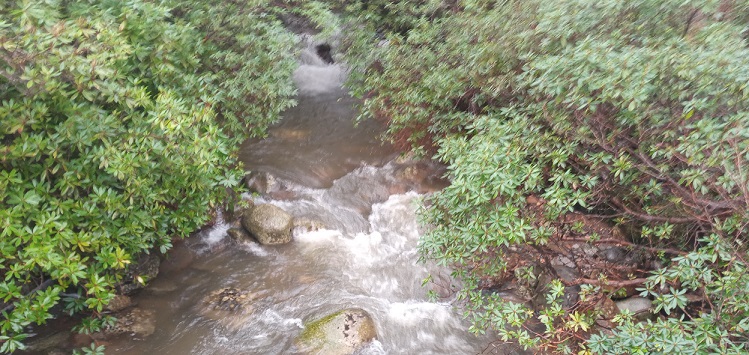
John Sinclair sent parkswatch more photos of the Allt Charnan two days ago. The water is not as cloudy as it was last month, when it featured in my post on the environmental damage that is being caused by the construction of the seven hydro schemes in Glen Etive (see here):
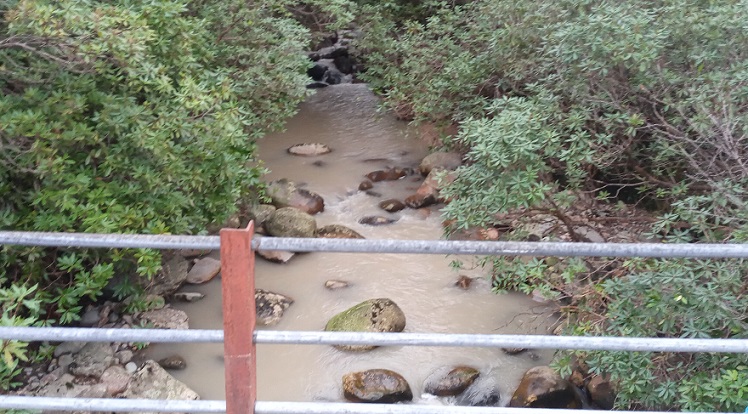
But two days ago the burn was significantly higher – the boulder centre bottom of both photos provides a reference point – and the flow of water far faster, as you can clearly see from the turbulence:
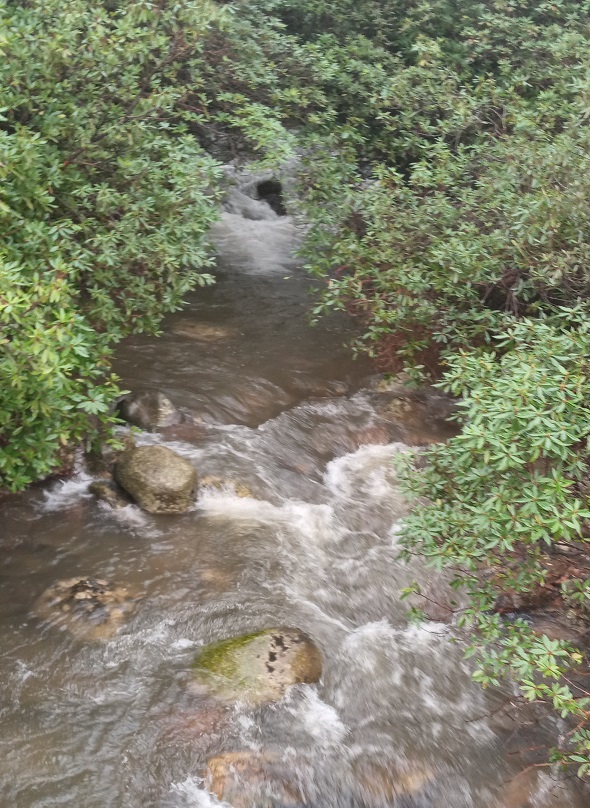 While to the casual observer of these photos the Allt Charnan might not look that full of silt, due to the volume of water it is likely that in fact more was being washed down the Allt Charnan on Wednesday than back in December. The destructive impact on aquatic life in the Allt Charnan and the River Etive below is likely to have been considerable.
While to the casual observer of these photos the Allt Charnan might not look that full of silt, due to the volume of water it is likely that in fact more was being washed down the Allt Charnan on Wednesday than back in December. The destructive impact on aquatic life in the Allt Charnan and the River Etive below is likely to have been considerable.
My December post was followed up by the Lochaber Times in January who reported that SEPA bosses had no current concerns regarding “significant environmental damage” and that Highland Council had received weekly reports from the Ecological Clerk of Works – whose job it is to prevent environmental damage – but “there has been a delay in uploading these to the electronic case file”.
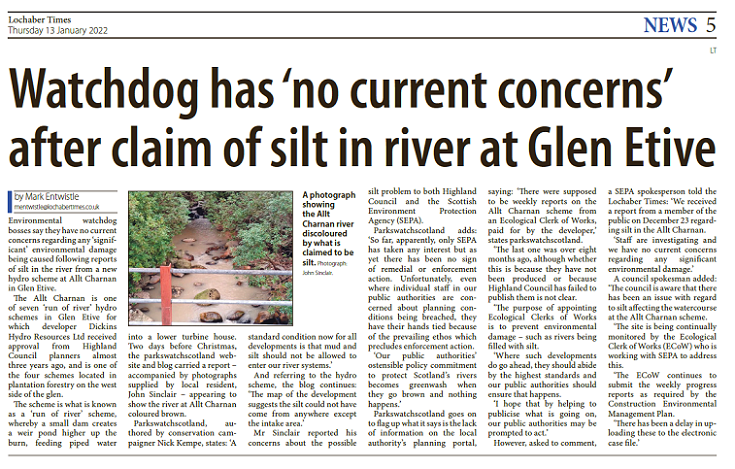
It is an interesting question what would cause SEPA bosses concern?
SEPA has produced a range of guidance which appears aimed at preventing silt from entering river systems, such as Engineering in the Water Good Practice Guidance, and its latest Guide to Hydropower Good Practice (2019), produced with NatureScot and Scottish Renewables is very clear:
“Keep clean water flows clean by not allowing them to mix with construction drainage (Page 16 of Good Practice Guide: Temporary Construction Methods describes this in more detail)”
The water in the Allt Charnan in December was opaque. What does this say about the commitment of SEPA bosses to uphold their own policies?
As for, Highland Council’s comments to the Lochaber Times, just how long does it take to upload the ECOW reports to the planning portal? I have checked today and the last ECOW report that has been uploaded to the planning application (see here) is still dated 5th April 2021:
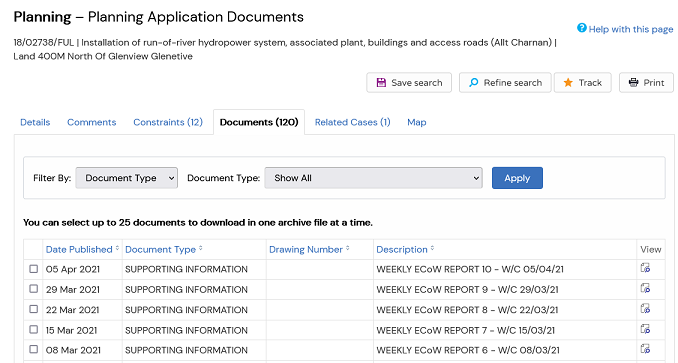
so it is
Even covered in the local press has still not been enough to force Highland Council to publish information which should be public. That makes it far more difficult for any member of the public to challenge whether the construction works at the Allt Charnan are being properly monitored or to raise questions about whether the environmental protections that are supposed to be in place are effective or not.
The Lochaber Times followed up their first article last week with an excellent piece of reporting:
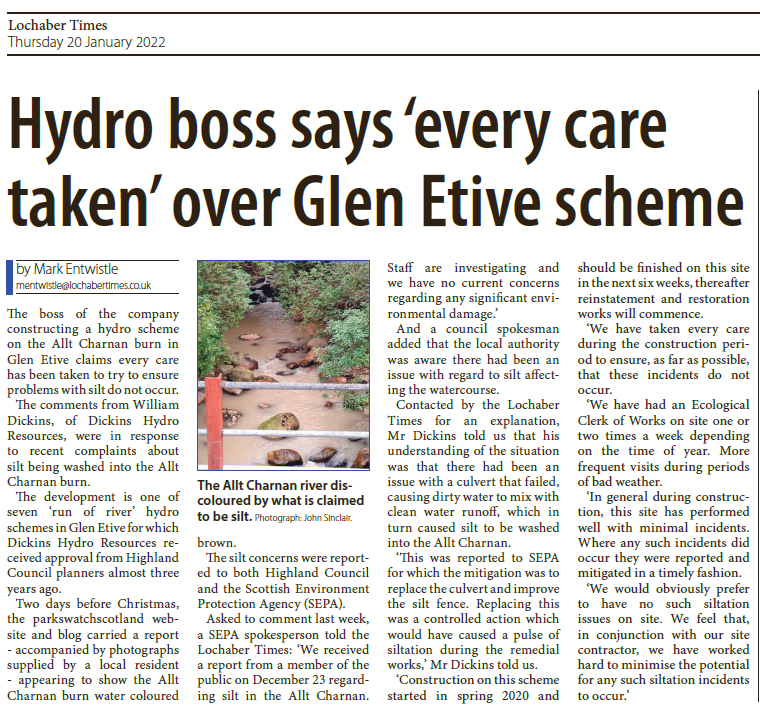 Mr Dickins not only claimed every care has been taken at Glen Etive to prevent silt entering the river system but that the problem was caused by a failed culvert and had been fixed. What John Sinclair’s latest photos show is either those claims are not true or a new problem has developed. (It hardly inspires confidence that Mr Dickins refers to “his understanding of the situation” rather than being able to state what is actually going on).
Mr Dickins not only claimed every care has been taken at Glen Etive to prevent silt entering the river system but that the problem was caused by a failed culvert and had been fixed. What John Sinclair’s latest photos show is either those claims are not true or a new problem has developed. (It hardly inspires confidence that Mr Dickins refers to “his understanding of the situation” rather than being able to state what is actually going on).
I hope to come back to the reasons why silt is being washed into the Allt Charnan in a further post but meantime there is evidence to show that the construction of these hydro schemes are causing other sorts of damage to the natural environment:
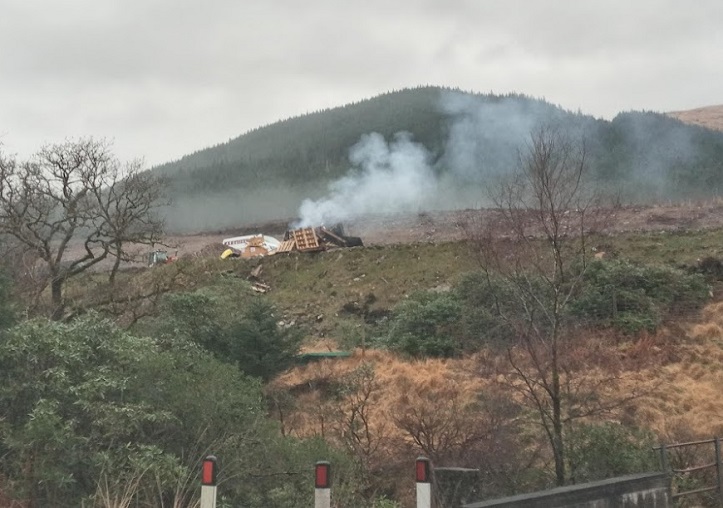
EU, Scottish Government and SEPA policy has been to reduce the amount of waste that is burned in the open environment to reduce air pollution and carbon emissions. Normally a license from SEPA would be required before construction waste, such as in the photo, can be burned. Unfortunately, it’s not possible for a member of the public to find out easily whether a license is in place as the information is not available online (SEPA’s systems were massively affected by a cyber attack two in 2020). Instead of being open and providing information that would help the public report breaches of environmental legislation, this is another example of how our public authorities are effectively sheltering developers from the law.
The Glen Etive hydro schemes were were given the go-ahead because they were supposed to be good for the environment but in practice there is clear evidence they are causing various types of damage to the natural environment. All sorts of construction related materials will have been brought into Glen Etive to construct the hydro schemes, but instead of recycling or re-using those that have not been used it is easier (and cheaper) just to burn them.
The Scottish Government has recognised the need to recycle and re-use materials in “Scotland 2045 Our fourth National Planning Framework for Scotland” which is currently out for consultation (see here). There is a section in it that highlights the requirement for more “Circular Economy Materials Management Facilities”:
“The range and scale of facilities required to manage secondary materials and their reprocessing back out into the economy is not yet clear. However, it is clear that sites and facilities will be needed to retain the resource value of materials so that we can maximise the use of materials in the economy and minimise the use of virgin materials in order to reduce greenhouse gas emissions. This is particularly significant for the construction and demolition industries and decommissioning industry.”
If we are to have any chance of addressing the climate and nature emergencies, we cannot afford to wait until things like more recycling facilities are constructed, we need to stop damaging construction practices now. That means public authorities like SEPA and Highland Council taking a far more proactive approach towards developments such as those taking place in Glen Etive.
The fundamental problem in Glen Etive was the attitude of Scottish Natural Heritage (now calling themselves NatureScot). It was SNH’s failure to sustain an objection to these hydro schemes during the planning process that has led to current difficulties. The degradation of wild land values and construction difficulties inherent in these proposed schemes was evident to everyone years ago, except SNH staff. If SNH has fulfilled its statutory responsibilities properly this would have led to a public inquiry which would almost certainly have resulted in a planning refusal for some if not all of these hopeless hydro schemes.
I agree, just another shameful event in their long pedigree of such.
I’m a bit puzzled at the relevance of ‘greater flow’ one day than the next. Surely this happens all the time naturally depending on rainfall?
And whilst burning waste on-site is not ideal, if it is properly managed (and I appreciate this is a big ‘if’) I can’t see how this would be more damaging than transporting it hundreds of miles to be disposed of ‘properly’.
And if the general theme here is that hydro schemes shouldn’t happen at all, well, we have got to get our electricity from somewhere and to my mind generating it renewably is a huge advance on burning fossil fuels. Surely the key is achieving a reliable source of renewable power whilst causing a minimum of environmental damage. As for the visual impact, well, sorry… that’s just nimbyism.
Martin, the point about the flow is when it is high it is likely to flush down even more silt – which in policy terms is not meant to happen – but in such conditions is very hard to see as the photos demonstrated. In terms of waste, the Scottish Government talks a lot about the circular economy but hydro scheme construction is miles from achieving that: all the lorries/boats transporting stuff in were going out empty. What is a general theme on parkswatch is that hydro schemes have been installed in some of Scotland’s finest landscapes – there is no constraint on where they can be constructed unlike wind turbines – and to make matters worse in many places like Glen Etive construction practices have been very poor and planning authorities have done nothing to control this. The carbon benefit of many of these hydro schemes is highly questionable – the total electricity produced by the Etive schemes equates to one wind turbine – and although you may not care personally about the landscape, caring for natural landscapes is what drives most people to want to care for the world.